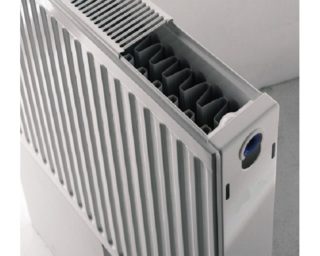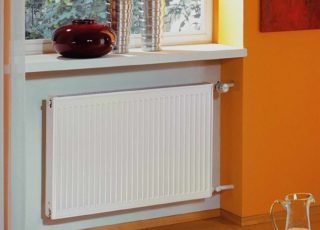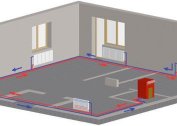Modern panel batteries are popular due to the combination of convector and radiator functions, simplicity and design efficiency. These are devices with increased heat transfer, which are quite economical at the same time. The primitive structure of such batteries eliminates problems during installation and other difficulties that may arise during installation. Before choosing the appropriate type of panel radiator, you need to choose the right connection option, study their pros and cons, as well as all the features.
Distinctive features of panel radiators
Steel panel radiators can be seen in most modern apartment buildings or private homes. They are versatile and practical, have an attractive appearance and are sold at affordable prices. Standard panel radiators are complemented by a front panel on the facade, which is made of durable stainless steel. Most often, such devices are equipped with heating circuits in private and low-rise buildings, since they are able to work at a working pressure of a low level of up to 10 atm and a temperature of up to +110 degrees.
For the manufacture of radiators of this type, Russian and European manufacturers use sheets of steel, which is welded using innovative technology. Inside the units there are special niches and channels designed to move the coolant. Additionally, the devices are equipped with U-shaped plates in an amount of not more than 3 pieces, which are needed for air convection. Due to their compact size and low weight, such products can be installed in any rooms and decorate external panels in various ways.
The height of the batteries does not exceed 300-900 mm, width 300-400 mm, which makes them an ideal choice even for small rooms.
Pros and cons of steel panel batteries
The main advantage of metal panel heating radiators is the budget cost and attractive appearance. Their advantages are especially noticeable when compared with cast iron or copper models. They are able to efficiently heat rooms and at the same time require much less energy for heating. The strong design allows you to mount them on walls made of any materials. The list of the main advantages of radiators include:
- reliability and lack of installation problems;
- high heat transfer due to the large area of the batteries and good convection;
- profitability up to 30-40% in comparison with analogues of cast iron and copper;
- spectacular appearance, which makes it possible not to spend money on the acquisition and installation of screens;
- wide range, the ability to choose from a wide range.
Panel heating batteries also have their drawbacks that must be taken into account. The list of weaknesses includes increased sensitivity of joints to water hammer, which is why it is necessary to additionally install a gearbox that can mitigate the impact. A tendency to rust, especially if the circulating fluid does not meet the desired level of quality. Scheduled shutdown of water significantly accelerates the appearance of corrosion and reduces the life of radiators.
On the instrument panel during operation or during transportation, defects and scratches may appear that provoke the development of rust.
Specifications
Steel home heating batteries are two plates connected by welding. Due to this connection, the space necessary for the free circulation of the heat carrier is formed inside, while the welds hold the plates securely. The steel of which the panel-type radiators are made is exposed to rust due to contact with the heat carrier, which provokes its gradual wear, reaching 0.1 mm per year. To reduce this indicator, batteries are coated with cathodic or anodic electrophoresis or by immersion.
In accordance with technical calculations and characteristics, panel batteries are divided into several types, taking into account the number of heat exchangers and the number of panels. Their life is long enough if the temperature during operation of the heat carrier will remain at around 70 degrees. It must be remembered that the maximum temperature of the liquid inside the system should not be higher than 100 degrees. Operating pressure during installation may not exceed 10 bar in order to avoid emergencies.
Connection options
There are several types of connection, including the bottom, diagonal and side. Each of them has its own characteristics, so when choosing you need to focus on the type of heating system, the area of the room, as well as other factors. It is best to contact specialists who will install the battery in accordance with the rules and standard standards.
Diagonal
This type of connection is suitable for single pipe systems. This method allows you to distribute hot water as efficiently as possible. When there are more than twelve sections in one radiator, special nozzles must be used so that the flow passes deep into the heating device. To clarify the exact number of sections, you need to calculate the power on the calculator in order to eliminate possible errors. Such a scheme allows the heat carrier to pass diagonally through the entire volume and evenly warm all sections.
Lower
Devices with this connection method are called universal. Their main advantage is complete invisibility and the ability to harmoniously fit the unit into the interior and space of any type. This is permissible through the use of corner and straight fittings, which are also called radiator binoculars in the language of plumbers. The complete set of units includes a thermostatic valve, thermal head and much more. Although they are not more expensive compared to radiators of other varieties, this is a good option for most modern houses and apartments.
Side
Devices with a lateral connection method are most popular among buyers, and not only because of the low price. Such radiators are switched in several ways, most often a one-sided type side circuit is used, due to which the potential of the device is fully utilized. Lateral diagonal connection is used only for units with a large number of sections, this option negatively affects the aesthetics, but provides an ideal level of heat output and heating.
How to choose the best steel panel radiators
When choosing a device of this type, first of all, attention is paid to its power and dimensions, which should correspond to the area of the heated room. To warm up 1 m2, you need at least 0.1 kW of heat. Since the heat output depends on the area of the units, the length of the radiator can be no more than 60-70% of the window width. Batteries from various manufacturers are represented on the market; among Russian brands, devices of the Lidea, Prado, and Konrad brands have proven themselves best. Consumers included Kermi, Buderus, Purmo, Axis, Rom and Lemax in the ranking of the best foreign brands.
Tips and maintenance
Even the highest quality device can fail if it is improperly maintained and the safety instructions are not followed. During the operation of panel radiators of any type, the following rules are observed:
- radiators with a temperature regulator of manual or mechanical type are considered the most practical;
- to prevent accidents and flooding, it is necessary to install ball valves that block the flow of heat carrier;
- to make the system work efficiently, they periodically pump out air from the inside.
It is not so difficult to choose steel panels for home heating, before that you should familiarize yourself with all available options in order to make the right choice, and seek the advice of specialists.






